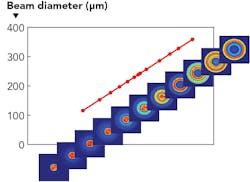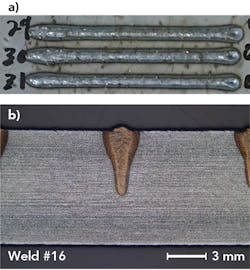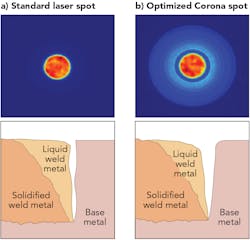Industrial laser welding continues to experience rapid growth, driven by numerous performance and cost advantages over alternative welding technologies. As laser welding makes inroads into existing products and enables new capabilities and applications for metal manufacturers, end markets are undergoing unprecedented change. For example, electrification and improved fuel economy demands are driving automakers to innovate in their design, assembly, and welding methods.
Fiber laser processing is one of the key technologies addressing these manufacturing opportunities. In combination with intelligent factory automation, fiber lasers provide highly reliable, cost-effective solutions for the growing welding market.
Lasers provide significantly faster throughput over conventional welding processes, with precise, low-heat-input welds, resulting in improved part quality and higher productivity. The high power and excellent beam quality of fiber lasers enables “keyhole welding,” characterized by high-aspect-ratio penetration profiles at fast travel speeds. In addition to the productivity benefit, the narrow fusion zone and high speed of keyhole laser welds produce low distortion with minimal heat-affected zones.
Using a larger laser spot size (with lower power density) results in shallower “conduction welding”—advantageous for aesthetic welds and for minimizing the need for post-processing steps. Transitioning between these two welding modes and optimizing the welding performance for different materials and joint designs requires different beam properties at the workpiece.
Beam-shaping optimization
For decades, industrial lasers have provided fixed output beam characteristics. Attempting to optimize this fixed beam profile to each welding application was primarily restricted to adjusting the optical magnification of the process head. Although a few niche applications used beam-shaping optics to improve the laser welding process, such as a twin spot wedge for zinc vapor mitigation or an axicon for ring beam shapes in deposition processes, these traditional methods add cost and complexity to the process head and are not widely employed.
Recent studies have shown that a fiber laser beam shape consisting of a central laser spot surrounded by an annulus or ‘donut’ can substantially improve the stability of a keyhole weld. This beam shape can reduce spatter and porosity, thus increasing joint strength and uniformity of the fusion zone.
For conduction welding, a high-intensity donut shape can be significantly more productive for the same weld profile than a traditional magnified or out-of-focus flat-top beam. With either keyhole or conduction mode, the optimum beam size and shape depends on the alloy, thickness, and performance criteria for the joint being welded.
Fiber laser breakthrough
To avoid the drawbacks of free-space optical methods, the nLIGHT Corona fiber laser uses all-fiber technology to enable rapid tuning of the fiber laser beam size and shape directly from the feeding fiber.1 These fiber lasers provide a wide range of beam shapes and sizes and allow rapid, on-the-fly beam tuning without any loss of power, stability, or reliability.
The Corona feeding fiber is divided into concentric zones that guide the laser beam, accommodating a wide range of applications. In one configuration, a feeding fiber with a 100-µm-diameter central core is surrounded by two annular guiding regions with diameters of 200 and 300 µm (FIGURE 1). The beam diameter and shape are tuned by varying the partitioning of the laser power among these three guiding regions, tuning the beam diameter from about 100 to 350 µm (second-moment definition), with the corresponding beam-parameter product (BPP) in the range of 3 to 18 mm-mrad.
The critical and unprecedented feature of this technology is that the tuning of the beam shape is accomplished within the fiber and with no free-space optics, thereby maintaining all the performance, stability, efficiency, and reliability advantages of fiber lasers. The full laser power is available at each beam setting, in contrast to beam-combination approaches that launch independent laser sources into different guiding regions and thus require excess laser power that is unavailable in most beam settings.
Corona technology offers a wide range of beam shapes, including flat tops, donuts with different sizes and thicknesses, and flat-top beams surrounded by donuts with different energy partitioning. Although continuous tuning of the beam shape between the minimum and maximum beam sizes is possible, a fixed number of settings (or “Index” values) is generally preferred for industrial applications.
An additional advantage of these fiber lasers is that beam tuning is very rapid, with a transition time from the smallest to the largest diameter of <30 ms. The fiber laser continues to operate at full power during an Index change, with no need to turn off (or “blank”) the laser power while changing the beam shape. This rapid tuning enables use of the optimum beam characteristics for each weld stitch (or the beginning and end of each weld), not just for different parts or different jobs.
Corona fiber lasers were first applied to sheet-metal cutting, with significant advantages over conventional fiber lasers for cutting of mild steel, stainless steel, aluminum, and copper. Several Corona-based cutting systems—capable of optimized cutting of thick and thin material without any hardware changes—are now on the market.2 Most recently, similar beam-shaping advantages have been demonstrated for welding applications as well.
Spatter reduction for steel welding
Laser welding is generally divided into two modes of operation: keyhole mode and conduction mode. During keyhole welding, the laser beam has sufficiently high power density to vaporize the metal. In the first few milliseconds at the start of the welding process, the laser energy melts and vaporizes a small portion of the metal surface. The metal vapor rapidly expands and escapes from the surface. This vapor ejection generates a recoil force on the liquid surface of the melt pool, creating a depression that lets the laser beam travel deeper into the metal to melt and vaporize more of the substrate.
Further metal vaporization strengthens the evaporative recoil force, thus pushing more liquid metal out of the way of the laser beam. This melt/vaporization process continues until a deep and narrow cylindrical cavity is formed in the metal surface. This cavity is called a “keyhole” due to the appearance of the small, deep opening visible on the surface of the weld pool. This keyhole is held open by the continuous stream of escaping metal vapor generated by the intense laser interaction.
The penetration profile of the fusion zone from a keyhole weld is very narrow with a high aspect ratio (depth/width). To produce a smooth weld surface with a constant penetration depth, the vapor cavity must be very stable. If the keyhole is unstable, intermittent discontinuities can be generated during the laser welding process.
While laser vaporization is striving to hold the keyhole open, forces such as surface tension and gravity try to collapse the liquid walls of the narrow vapor cavity. When the keyhole intermittently collapses, discontinuities such as pores, spatter, and surface irregularities can occur.Unfortunately, minor instabilities in the keyhole can lead to spatter generation (FIGURE 2). When the liquid pool collapses and closes the keyhole, laser vaporization reopens the cavity, ejecting small droplets (spatter) from the melt pool.
When welding medium- and high-carbon steels, spatter generation is quite common and difficult to avoid with standard processing techniques (FIGURE 3). Weld cross-sections for a medium-carbon steel (AISI 4140) show that, despite the spatter, there is no significant effect on the penetration profile.While this case resulted in a sound weld, the spatter can still be a major problem for the product or process. In powertrain welding applications, for example, spatter is not acceptable because metal particles in the final product can damage the assembly. In addition, the buildup of spatter on the weld fixtures can lead to process impacts, downtime for cleaning fixtures, or expensive consumable tooling.
The most successful way to consistently reduce spatter is by improving keyhole stability and preventing the vapor cavity from collapsing. Historically, to achieve this goal, users have tried moving the process out of focus to produce a larger beam with a more Gaussian shape. This approach generally works, but is more sensitive to process standoff and drastically reduces the power density and therefore the processing speed, the penetration, or both.
Alternatively, power modulation has shown some success in improving keyhole stability by oscillating laser power during the weld. This technique works for some alloys, but it requires a higher peak power to maintain equivalent average power, speed, and penetration, and is very sensitive to process changes. Lately, beam oscillation or wobbling has been demonstrated to improve keyhole stability in a variety of metals, but due to limitations on scanning frequency and practical laser power, the maximum linear travel speed to perform stabilized-keyhole wobble welding is relatively low.With fiber laser beam shaping, however, users are able to direct the laser power where it is needed to open the keyhole without significantly affecting travel speed or penetration depth. An annulus of laser power around the central beam can widen the keyhole opening to avoid collapse of the vapor cavity (FIGURE 4).
For steel welding, the central beam provides the main penetrating power, while the added annulus produces extra vaporization at the top of the keyhole to consistently maintain the enlarged opening. For bead-on-plate welds, the fraction of the laser power contained in the annulus can be increased during processing (FIGURE 5). With constant laser power and speed, the weld width increases as the annulus power is increased, and the corresponding change in aspect ratio is evident in the weld cross-section. For the same medium-carbon steel alloy previously discussed, Corona Index settings 5 and 6 showed the lowest spatter generation while achieving the target penetration depth of 4 mm.As demonstrated in this automotive welding example, fiber beam shaping is a major improvement compared to traditional fiber lasers and bulk-optic beam-delivery technologies for metal processing. Beyond the obvious freedom to adjust the beam shape for increased keyhole stability, reduced spatter, reduced porosity, and improved weld aesthetics, in-fiber beam shaping eliminates the need for external fiber couplers and switches, motorized optics, or zoom process heads. With rapid beam-shape switching (<30 ms) on-the-fly, Corona fiber lasers provide 100% of the power where and when it is needed for optimal processing of a range of materials, joint designs, or job mixes, providing unprecedented versatility.
Already established in the sheet-metal cutting market, the all-fiber beam shaping provided by Corona lasers enables advantages in welding to address a growing list of established and emerging applications, driving a new phase of growth in the industrial laser welding market.
REFERENCES
1. D. Kliner, R. Farrow, and B. Victor, Laser Focus World, 55, 4, 45–48 (Apr. 2019).
2. D. Kliner and B. Victor, Industrial Laser Solutions, 33, 5, 23–26 (Sep/Oct 2018).





